Aylesbury Vale Area Design Supplementary Planning Document
2. Design Process
2.1 The design process
2.1.1 In order to deliver good design there are a number of important steps that must be taken. These steps are indicated in the simple flowchart in Figure 2.1.
2.1.2 The level of detail, and engagement required, will be dependent on the scale and complexity of the application.
Engaging professionals
2.1.3 This Design SPD alone cannot produce good creative solutions; this is the job of a creative professional. One of the first stages in preparing a design scheme will be to engage skilled design professionals to ensure high-quality solutions through the design process.
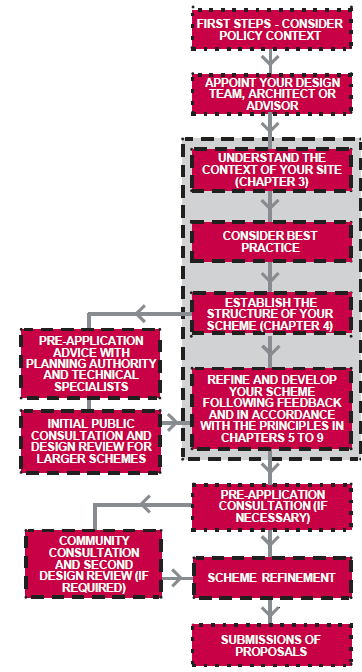
Figure 2.1: Flow chart setting out the design process for preparing a design proposal with reference to the relevant chapters in this Design SPD
2.1.4 The council strongly encourages householders, local builders, developers and any other organisation commissioning design to employ appropriate design professionals such as architects, landscape architects, ecologists, arboricultural consultants, heritage consultants and urban designers.
2.1.5 There are a number of organisations which can assist including:
- Landscape Institute https://www.landscapeinstitute.org
- Royal Institute of British Architects
https://www.architecture.com - Royal Town Planning Institute
https://www.rtpi.org.uk - Urban Design Group
https://www.udg.org.uk - Chartered Institute of Ecology and Environmental Management
https://cieem.net/ - Arboricultural Association
https://www.trees.org.uk/ - Institute of Historic Building Conservation
https://www.ihbc.org.uk/
Understanding the planning context
2.1.6 National and local planning policies will influence whether a site is suitable for development and the form and nature of this development. One of the first things that an applicant should do is to carry out research to understand relevant planning policy that relates to their site.
2.1.7 The Development Plan for the area is the Vale of Aylesbury Local Plan 2013 – 2033 together with a number of Neighbourhood Plans, which cover a significant part of the area.
2.1.8 The Local Plan can be found on the council website. Go to council website
2.1.9 The Neighbourhood Plans can be found on the council website. Go to council website
2.1.10 Aylesbury Garden Town (AGT) is the focus for much of the area's growth. The Vision for the Garden Town is set out in Policy D1 of the VALP and in the AGT masterplan. Further detail about the Garden Town is provided in Section 3.6.
2.1.11 There are also other supporting policy or strategy documents that may relate to a site. These may include Supplementary Planning Documents, Conservation Area Appraisals, Historic Character Area Assessments and Masterplans, which have been adopted or endorsed by the council.
2.1.12 Information on heritage, trees, ecology and conservation can be found on the council website. Go to council website
2.1.13 Details of other documents endorsed or adopted by the council are available on the council website. Go to council website
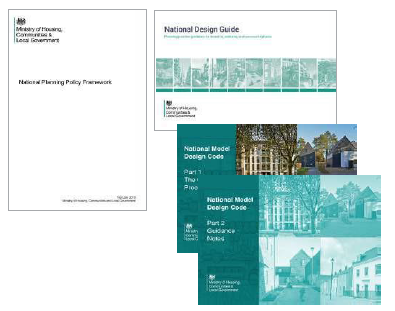
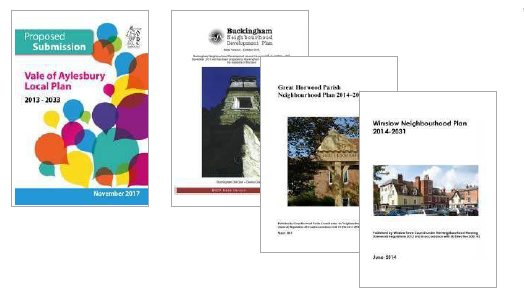
Left: Figure 2.2: National policy guidance documents: the National Planning Policy Framework (NPPF), National Design Guide and National and National Model Design Code (Part 1 and 2). Right: Figure 2.3: Local policy guidance documents: Vale of Aylesbury Local Plan and Neighbourhood Plan documents
2.2 Who to talk to
Early engagement
2.2.1 Depending on the scale of development, applicants should consult with relevant statutory and non-statutory authorities and council officers to understand their policy requirements and initial advice. Some of the more important relevant organisations are listed in Figure 2.4. This list should not be seen as being comprehensive.
Pre-application consultation
2.2.2 Applicants should hold pre-application discussions at an early stage in the design process. This will provide an important opportunity to identify and discuss emerging ideas and sensitivities and to ensure that the design process is heading in the right direction.
2.2.3 Pre-application discussions also provide an opportunity to discuss the information and level of detail required to accompany a particular planning application and an opportunity to get specialist technical advice for instance on heritage matters.
2.2.4 Planning Performance Agreements (PPAs) are recommended for larger applications. Information is provided at the on the council website. Gotocouncil website
2.2.5 Pre-application advice may be subject to charges. Details of fees and charges can be found on the council website. Go to council website
Community consultation
2.2.6 Depending on the scale and nature of an application it may be appropriate to carry out consultation with the public and stakeholders. Applicants should refer to the Buckinghamshire Council's Statement of Community Involvement which sets out a Code of Practice for consultation. This can be found on the council website. Go to council website
2.2.7 Community engagement can be a useful way to discover more about a site and its setting and to gain an understanding of any concerns that the community may have in relation to an application.
2.2.8 Applicants should document the engagement process and demonstrate how community and stakeholder feedback has been taken account of in their proposals.
2.2.9 The council encourages all applicants and their agents to consult their neighbours before they submit a planning application.
Refining proposals
2.2.10 Applicants should refine their proposals in light of pre-application discussions and community consultation responses. It is the job of the applicant and the design team to review the design and to try to satisfy concerns.
2.2.11 Applicants will be expected to outline all consultation responses and how these have been considered.
Relevant Statutory Authorities and organisations
- Natural England: Landscape, Green Infrastructure and Biodiversity;
- Chilterns Area of Outstanding Natural Beauty;
- Historic England: heritage assets;
- Environment Agency: flooding, rivers and water pollution although Buckinghamshire Council are the Lead Local Flood Authority;
- Utility companies;
- Police service: police liaison and crime prevention officer;
- Fire service; and
- Town and parish councils.
Figure 2.4: Organisations that might be relevant to consult to for pre-application advice
Submission of proposals
2.2.12 The level of information that the council will require the applicant to submit as part of a planning application will depend on the scale and nature of the proposal.
2.2.13 Where proposals affect a listed building, listed building consent is required for all works of demolition, alteration or extension that affect its character as a building of special architectural or historic interest. Check with the Council to confirm whether listed building consent is required. Refer to Chapter 4, DES17 for further details..
2.2.14 Reference should be made to the Local Validation List to understand the documents that will need to be submitted. This can be found on the council website. Go to council website
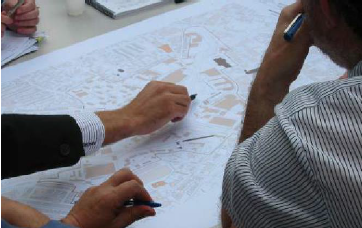
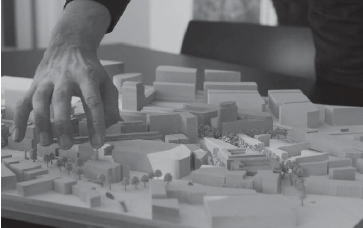
Design Review
2.2.15 The NPPF advocates the use of design review to improve the quality of development (NPPF July 2021, paragraph 133). The council will either utilise an existing panel (e.g. BOBMK) or establish a new design review panel or other review process, to provide independent and professional design advice and evaluation of significant schemes, either by virtue of their scale or sensitivity, that are proposed in the area. Consideration is being given to establishing a pilot Design Task Force to raise the quality of design in the Aylesbury Garden Town.
2.2.16 Design review can be a highly effective process which provides constructive criticism and challenge to project designs by peer review. It is applicable to a wide range of design projects including masterplans, buildings, landscapes, streets and spaces. Applicants should discuss the requirement for design review with the council as part of their pre-application discussions. Applicants will be expected to pay for the design review service.
2.2.17 Schemes should be presented to the panel early in the design process when the panel's inputs can be most helpful and influential and again later in the design process when the scheme is more fully developed closer to the submission of a planning application. The council will have regard to the recommendations from the design review panel when assessing applications.





